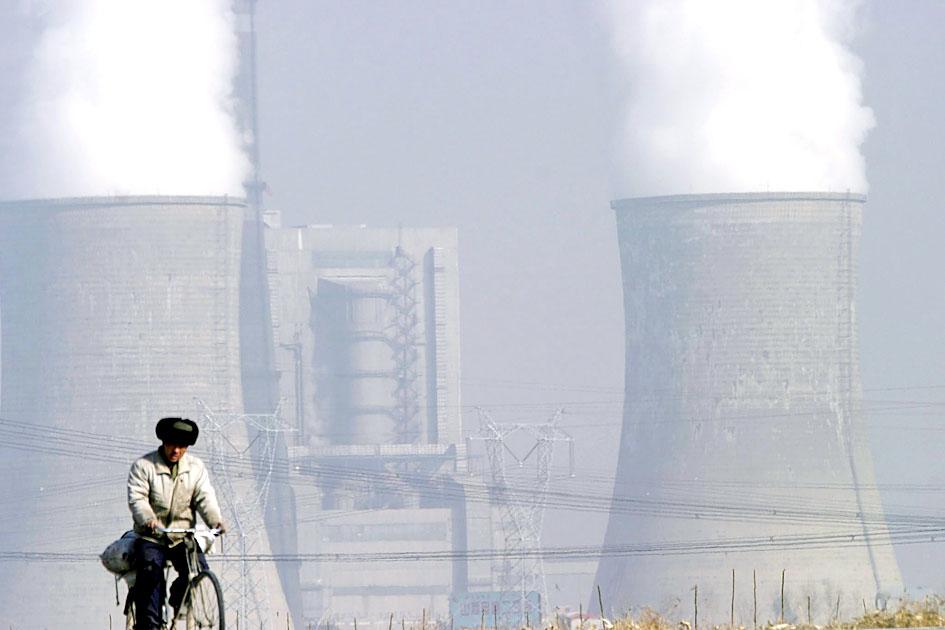A villain is emerging in China’s efforts to rein in its energy prices: inefficient, power-hungry industry.
With flooding in the coal hub of Shanxi Province driving prices up to 1,508 yuan (US$234) a metric tonne even as the government tries to kick-start extra production, further measures are clearly needed to prevent more generators cutting off their turbines and causing blackouts through the cold of northern China’s winter. That means a crackdown on the factories that still consume the lion’s share of electricity.
Industry makes up only 25 percent of grid demand in the US, but in China it is fully 59 percent of the total — more than all the country’s homes, offices and retail stores put together.

Photo: EPA-EFE
Cheap power has been an essential tool of development, and the government has traditionally encouraged major users with electricity tariffs that get cheaper the more you consume. With about two-thirds of the grid powered by coal, the cost of digging up the black stuff has determined how much industrial users pay for their power.
The problem is that coal is not getting any cheaper. After a sustained period of deflation prior to 2016, when a glut of dangerous and unregulated mines was closed down, annualized costs jumped 40 percent in 2017. They did not really fall again until COVID-19 struck, and they have since rebounded with a 57 percent increase from 12 months earlier in August.
Such increases might be tolerable if end-users were turning this power into high-value goods — but all too often, that is not the case. China consumes more electricity per capita than the UK and Italy, but comes nowhere close in terms of economic output.
Determined to hit Chinese President Xi Jinping’s (習近平) targets on peaking emissions by 2030 and hitting net zero by 2060, Beijing’s policy makers have fixed on so-called “dual high” sectors — those whose energy consumption and carbon emissions are both elevated — as the culprits.
These are many of the industries that have grown fastest in the past few decades, such as cement, steel, base metals, oil refining, chemicals and glass. They collectively account for more than half of China’s emissions.
Under revised rules issued by the economic planners at the Chinese National Development and Reform Commission this week, residential and agricultural consumers would still buy power at fixed tariffs and smaller users would see electricity costs fluctuate within a band.
“Dual-high” sectors, on the other hand, would see no guardrails on the prices they pay. As a result, all the cost of balancing utilities’ books would fall on their shoulders.
This would reduce the demand pressure on the grid and encourage inefficient users to upgrade to add more value, Wan Jinsong, the commission’s director of prices, told a news conference on Tuesday.
This sounds like a neat solution — but we should not underestimate the way ripples will spread. In the past few decades, the world has become hooked on cheap Chinese power for making a host of its goods. About half of all metal is produced in China and nearly one-fifth of all oil is refined there. Energy-hungry products from aluminum to solar panels to bitcoin depend on the country’s low industrial power tariffs to keep their own prices down.
With electricity costs for dual-high industries set to rise, we might not have seen the end of the inflationary pressures flowing through the global economy from those flooded Shanxi mines.
If Beijing wants to manage this transition without crippling the economy, it is going to need to release pressure on the supply side of the energy system at the same time as taking measures to reduce demand growth.
That is where renewables come in. At the same time that price curbs are being removed from dual-high industries, so capacity curbs are being lifted from zero-carbon power generation. Provinces previously faced absolute limits on the amount of electricity they were allowed to consume, a factor that might have contributed to the most recent cuts. In the future, those bars would be removed for renewable generation, giving governors a strong incentive to switch away from constrained, inflationary coal-fired energy to unlimited, fixed-cost wind and solar.
With zero-carbon electricity already cheaper than most existing operating coal power plants, those changes might be just the spur to wean China from its addiction to solid fuel. The bulk of generation would be able to move to wind, solar, hydro and nuclear. Thermal power plants would increasingly find themselves ramping up and down to capture daily peaks in demand, with differential pricing through the day giving them the opportunity to make profits after the sun has set and when the wind drops.
All that is needed to make this system work more efficiently is for Beijing to unleash the formidable investment appetites of its provincial governments on the banquet of cheap zero-carbon power now available.
Until now, China has shied away from the sort of rapid transition that it, and the global climate, needs. The teetering state of its coal-fired power system ought to be just the catalyst to accelerate that shift.
David Fickling is a Bloomberg Opinion columnist covering commodities, as well as industrial and consumer companies. He has been a reporter for Bloomberg News, Dow Jones, the Wall Street Journal, the Financial Times and the Guardian.
This column does not necessarily reflect the opinion ofthe editorial board or Bloomberg LP and its owners.

CHIP RACE: Three years of overbroad export controls drove foreign competitors to pursue their own AI chips, and ‘cost US taxpayers billions of dollars,’ Nvidia said China has figured out the US strategy for allowing it to buy Nvidia Corp’s H200s and is rejecting the artificial intelligence (AI) chip in favor of domestically developed semiconductors, White House AI adviser David Sacks said, citing news reports. US President Donald Trump on Monday said that he would allow shipments of Nvidia’s H200 chips to China, part of an administration effort backed by Sacks to challenge Chinese tech champions such as Huawei Technologies Co (華為) by bringing US competition to their home market. On Friday, Sacks signaled that he was uncertain about whether that approach would work. “They’re rejecting our chips,” Sacks

NATIONAL SECURITY: Intel’s testing of ACM tools despite US government control ‘highlights egregious gaps in US technology protection policies,’ a former official said Chipmaker Intel Corp has tested chipmaking tools this year from a toolmaker with deep roots in China and two overseas units that were targeted by US sanctions, according to two sources with direct knowledge of the matter. Intel, which fended off calls for its CEO’s resignation from US President Donald Trump in August over his alleged ties to China, got the tools from ACM Research Inc, a Fremont, California-based producer of chipmaking equipment. Two of ACM’s units, based in Shanghai and South Korea, were among a number of firms barred last year from receiving US technology over claims they have

It is challenging to build infrastructure in much of Europe. Constrained budgets and polarized politics tend to undermine long-term projects, forcing officials to react to emergencies rather than plan for the future. Not in Austria. Today, the country is to officially open its Koralmbahn tunnel, the 5.9 billion euro (US$6.9 billion) centerpiece of a groundbreaking new railway that will eventually run from Poland’s Baltic coast to the Adriatic Sea, transforming travel within Austria and positioning the Alpine nation at the forefront of logistics in Europe. “It is Austria’s biggest socio-economic experiment in over a century,” said Eric Kirschner, an economist at Graz-based Joanneum

France is developing domestic production of electric vehicle (EV) batteries with an eye on industrial independence, but Asian experts are proving key in launching operations. In the Verkor factory outside the northern city of Dunkirk, which was inaugurated on Thursday, foreign specialists, notably from South Korea and Malaysia, are training the local staff. Verkor is the third battery gigafactory to open in northern France in a region that has become known as “Battery Valley.” At the Automotive Energy Supply Corp (AESC) factory near the city of Douai, where production has been under way for several months, Chinese engineers and technicians supervise French recruits. “They